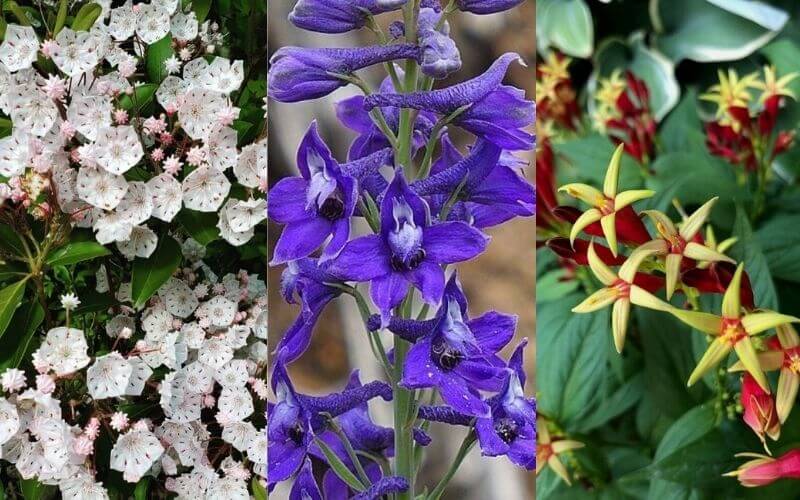
Plant these flowering flower plant species to your garden or hanging basket for attracting hummingbirds to your landscape.
There is more to a garden than flowers and leaves… There can be “rooms”, sculptures and water features. But there can also be bees, butterflies and hummingbirds.
And what a joy is it to see this smallest of birds fluttering among your flowers? That is, of course, if you choose the right hummingbird flowers, those that attract these very special – and beautiful – little flying visitors…
What is a hummingbird’s favorite flower? Hummingbirds love brightly colored tubular flowers that fit their bills; it does not matter if they are large perennial tree and shrubs, like big berry Manzanita, climbers like trumpet vine or clematis or small herbaceous plants, like bee balm, columbines and beardtongues.
What flower colors attract hummingbirds? Hummingbirds have an eye for bright colors, but their absolute favorite is red, the most visible color of all. In fact, these flying visitors have no sense of smell, will not miss the vibrant hues of your lupines, cardinal flower, coral bells, summersweet or scarlet sage.
Whether you want hummingbirds to visit your borders or bed, whether you want to attract them with perennials or annuals, with big or small plants, you will need to choose among the plants that this tiny flying wonders love to visit.
Thant’s why to give you an idea we’ve put together this list of 20 flowering plants that attract hummingbirds add to your garden collection, along with handy tips to make sure your flying visitors find them string and healthy!
Just grow them in the right spots and with the correct care, and these plants will fill with hummingbirds!
Help Your Flowers Attract Hummingbirds with Some Tips and Tricks
If hummingbirds are after the sweet nectar of your flowers, it is also true that you can give your garden plants a helping hand; with a few “tricks of the trade” and little well designed touches and changes yo your garden, you can make sure that it becomes irresistible to your little winged guests.
Simple, isn’t it? All you need to know now is which flowers you can grow in your garden to make sure it fills with hummingbirds, and here they are!
20 Best Flowers That Attract Hummingbirds To Your Yard
What flowers attract hummingbirds? There are many flowers that will attract hummingbirds to your garden, but they have some characteristics in common: bright colors (especially red) and tubular shape. Here are 20 absolute best flowering plants that attract hummingbirds to your garden or landscape
1. Trumpet Vine (Campsis radicans)
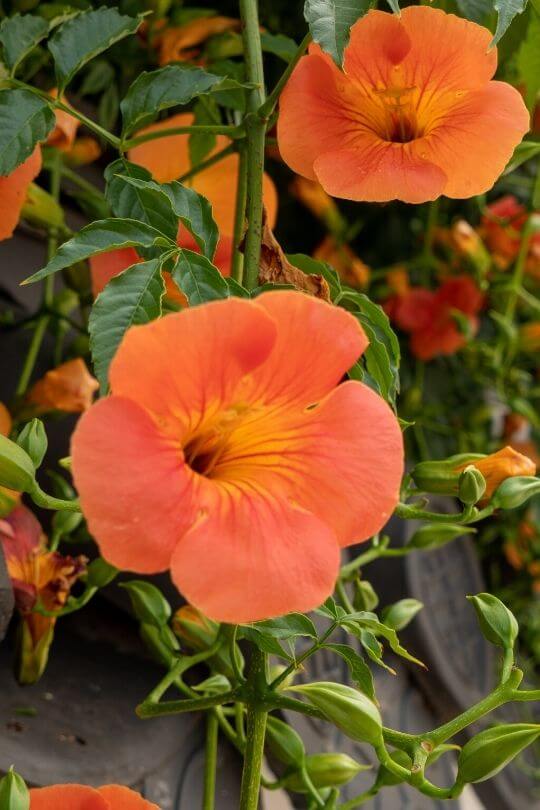
A wonderful presence in any garden, trumpet vine is a strong and vital climber with lush pinnate leaves and brightly colored, large trumpet shaped flowers, which will come in great abundance during the blooming season, in summer.
Trumpet vine will provide an outstanding display on trellises, pergolas or growing on tall fences and, while it originates from the New World, it has become a regular presence in Mediterranean gardens.
It will also spread fast, even becoming naturalized in the right habitat.
2. Butterfly Bush (Buddleia davidii)
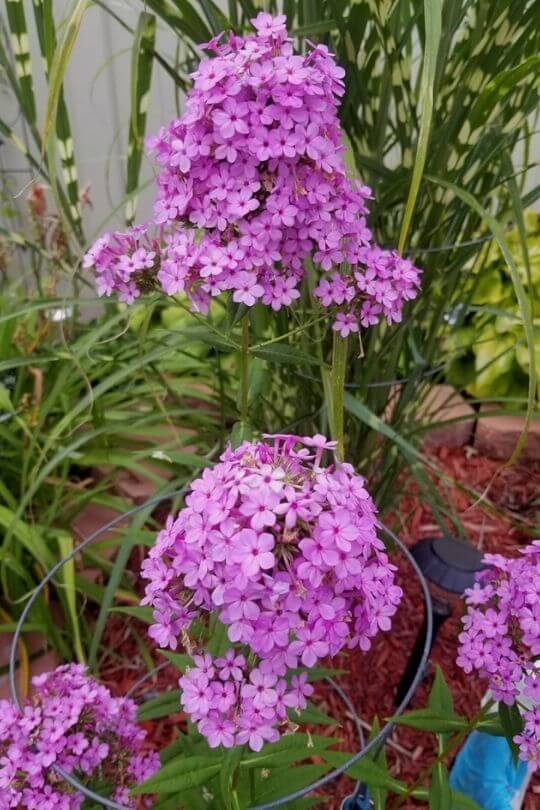
Called “butterfly bush” for obvious reasons, this wonderful garden shrub is also a favorite with hummingbirds.
Its beautiful arching branches that end in large, violet to purple racemes with a multitude of tubular flowers on them is a real feats for these nectar loving hummingbirds.
Its “old world” and romantic look makes this plant ideal for informal, traditional looking gardens and cottage gardens, where you can use it in hedges and borders, or as a standalone shrub.
While it can grow to quite impressive heights (16 meters), there are dwarf cultivars like ‘Blue Chip’ and ‘Tutti Frutti Pink’ that can fit in a small flower bed or even in a container in a terrace.
3. Lupine (Lupinus spp.)
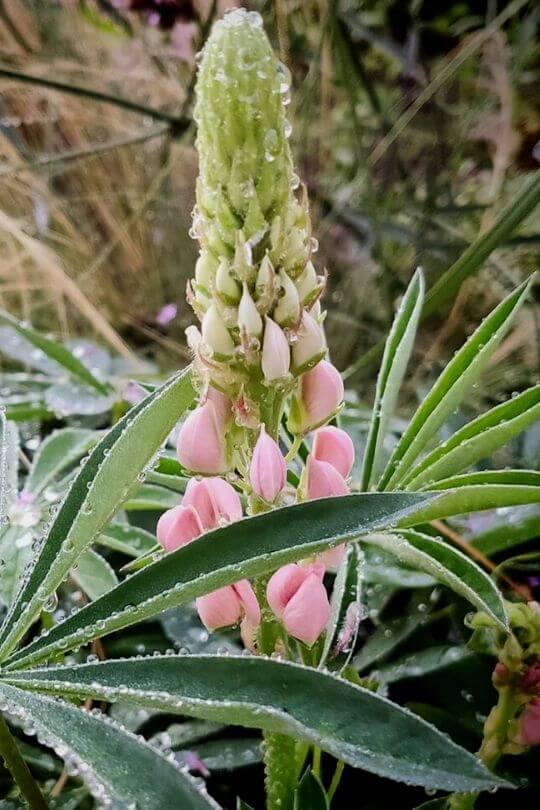
With beautiful, tall spikes filled with colorful flowers, lupine is irresistible to hummingbirds.
The flowers grow like cones of color opening from the base up, lasting from late spring to early summer, rising among beautiful digitate leaves that grow on erect stems, giving this plant a natural yet architectural quality that will certainly enhance your garden.
Lupine is not an option in cottage gardens; it is a must, but it will look well in all borders and medium to tall flower beds, especially if you want a richly colored but natural, rural look.
The flowers can be of many colors, from white to purple via blue, punk and orange, but if you are after red blooms for attracting hummingbirds, then the cultivar ‘Beefeaters’ is a safe choice.
4. Texas Indian Paintbrush (Castilleja indivisa)
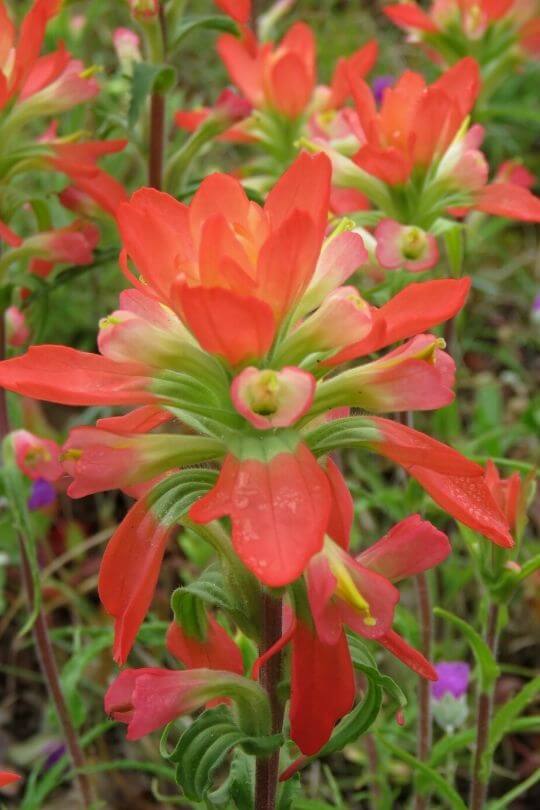
While this plant is not very well known to amateur gardeners, it is to hummingbirds! It will produce beautiful erect spikes of a bright and vibrant red color that these flying nectar lovers will not miss.
The flowers are actually small and cream in color, but they are surrounded by crimson bracts that give this plant its main attraction.
This is a great annual (or biennial) herbaceous plant for wild meadows, prairies, cottage or informal gardens and, while you will get hundreds of plants from a pinch of seeds, it needs to grow among other plants, as it needs their root system to survive.
5. Scarlet Sage (Salvia splendens)
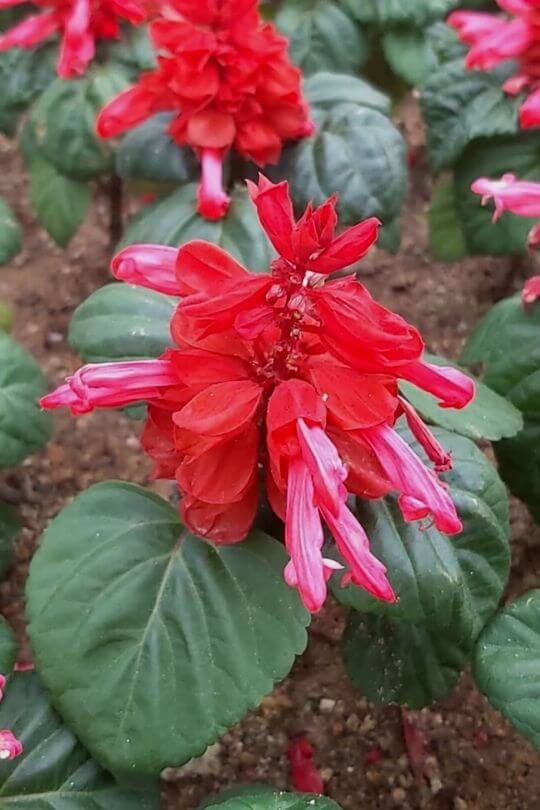
Scarlet sage is a bloomer like no other: from late spring to fall, it will keep producing bright red, in fact usually scarlet, flowers without stopping. No wonder humming birds go mad for it…
While there are now new cultivars with flowers of virtually all colors, the scarlet variety is best for hummingbirds, and it will liven up borders, flower beds and cottage gardens till the first frost arrives.
6. Columbine (Aquilegia vulgaris)

How can you not love the beautiful drooping flowers of columbine?
Elegant and delicate in appearance, the flower heads look to me like Chinese lanterns hanging down on top of straight stems, while the beautiful ternately compound leaves (which means divided into groups of three, lobed leaflets) will form a little shrub just under the blossoms.
And guess what? Hummingbirds love them too, and they will come to visit them in your flower beds, birders or any informal garden where you wish to grow this amazing perennial.
7. Cardinal Flower (Lobelia cardinalis)
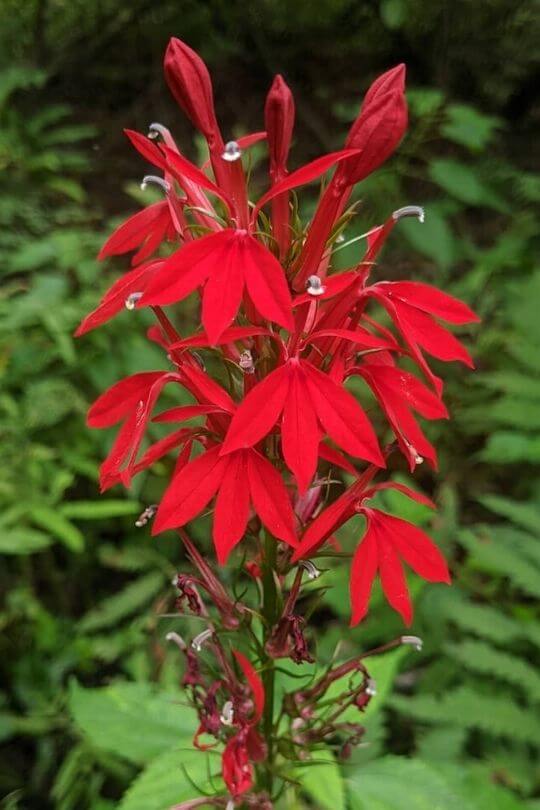
This perennial has won the Award of Garden Merit by the Royal Horticultural Society thanks to its deep cardinal red inflorescences, which grow on erect spikes, like beacons for hummingbirds above the hunter green foliage.
Like all lobelias, the flowers have the typical “protruded lip” shape, but this species is particularly good for hummingbirds because it id fairly tall as well as for its color.
This hummingbird flower perfect for borders and beds, and it grows well next to water as well.
8. Woodland Pinkroot (Spigelia marliandica)
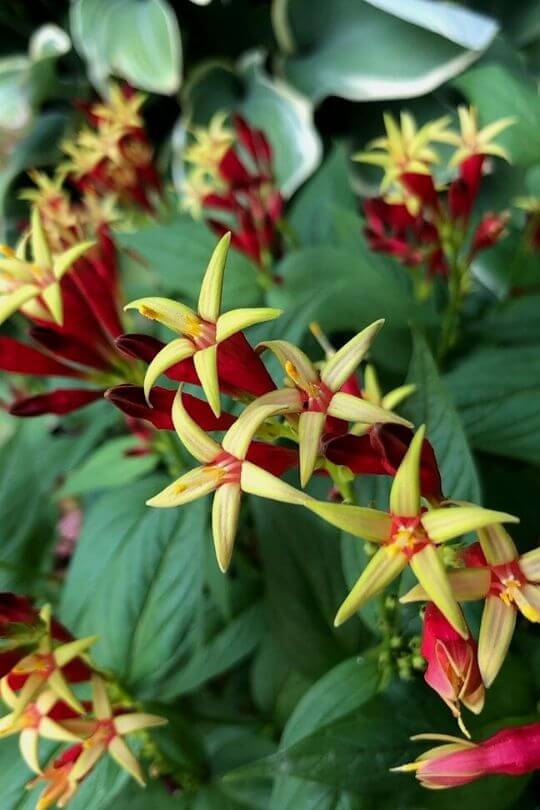
If you need a fairly low perennial plant to complete your hummingbird border, then Woodland pinkroot has all it takes…
It has long, waxy and tubular red flowers on the outside, with yellow to line green, star shaped petals; it is rich in nectar and it will also grow in those difficult shady corners of your garden.
If you deadhead the flowers, you will prolong the flowering season, so you will see the vibrant red “drops” on top of the rich green elliptical leaves for longer. What is more, this plant is very easy to grow and and fairly adaptable.
9. Hummingbird Mint (Agastache ‘Bolero’)
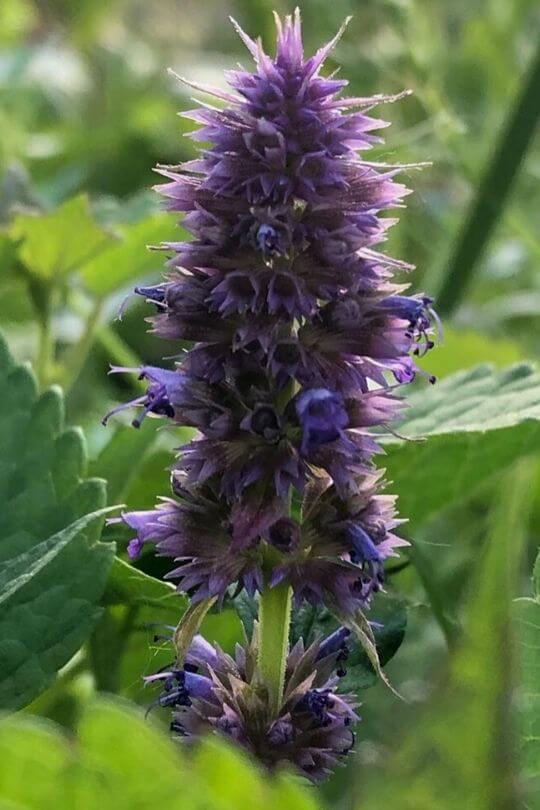
The name of this perennial garden plant, hummingbird mint, should give it away…
Yes, with its long, beautiful plumes of purple pink to magenta tubular flowers waving above the rich foliage from mid summer to fall, this is a favorite source of nectar for our lovely little birds…
But there is more, the lush foliage will turn from the deepest green on purple stems to copper as the season progresses while still in bloom, adding vibrant colors to your borders or flower beds though, because it can stand rocky soil, it is an ideal choice to attract humming birds to your rock garden!
10. Summersweet (Clethra alnifolia ‘Hummingbird’)
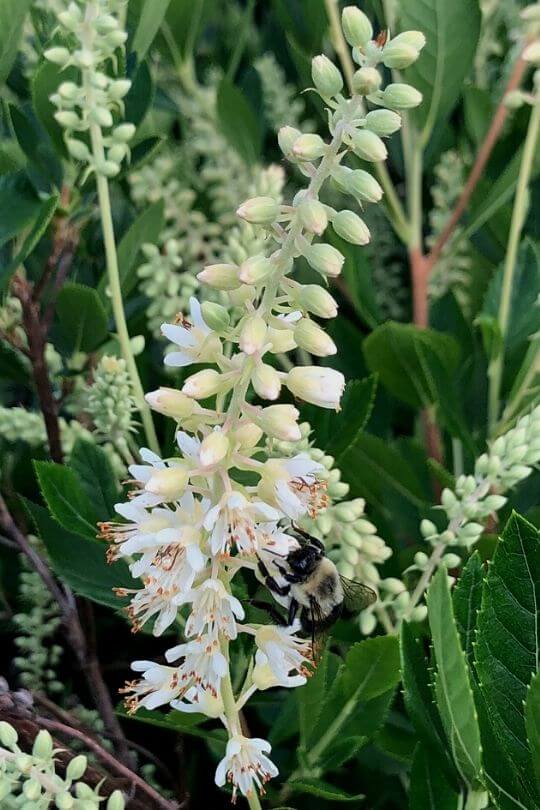
Here is another plant that takes its name from hummingbirds and another winner of the Award of Garden Merit by the Royal Horticultural Society.
With strong and sweet scented white spikes that fill the air and the leafy shrubs from midsummer to fall, summersweet’s compact growth is a gold mine of nectar for hummingbirds, but also bees, butterflies and all pollinators.
This is a very popular cultivar for its generosity, but also because it gives it best blossoms in full shade, thus solving lots of problems for poorly lit hedges and borders, even next to ponds or streams and it is ideal for coastal gardens as it is salt resistant.
11. Coral Bells (Heuchera spp.)
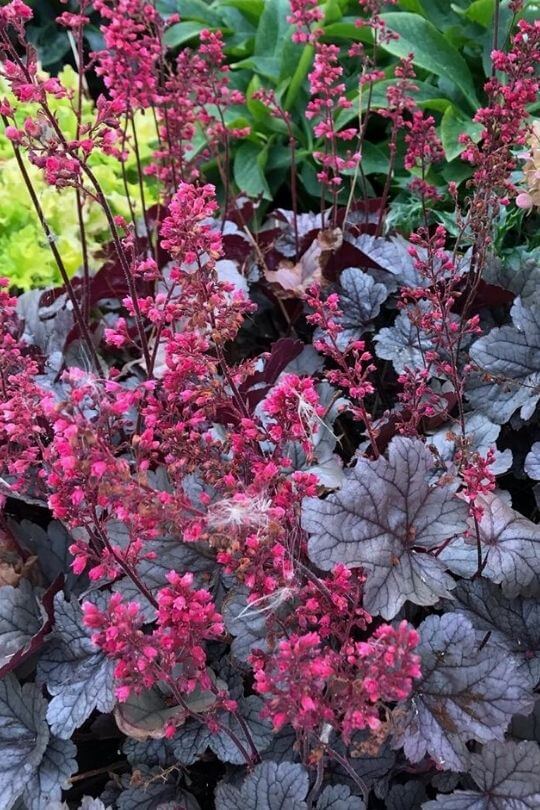
Looking for a small plant to keep company to your summersweet and attract hummingbirds to your borders and flower beds? Then coral bells, with its beautiful, lush and colorful large leaves, topped with spikes of beautiful bell shaped flowers is just what you need!
There are many varieties of coral bells too. For example, ‘Bella Notte’ has deep purple leaves and bright reddish pink flowers, while ‘Champagne’ will give you a still striking but more sophisticated look with its gold to peach purple leaves and peach flowers.
And if you want to add an extra touch of red to attract hummingbirds, then mix in ‘Chocolate Ruffles’ whose ruby to purple foliage cannot be missed even from a distance!
12. New Jersey Tea (Ceanothus americanus)
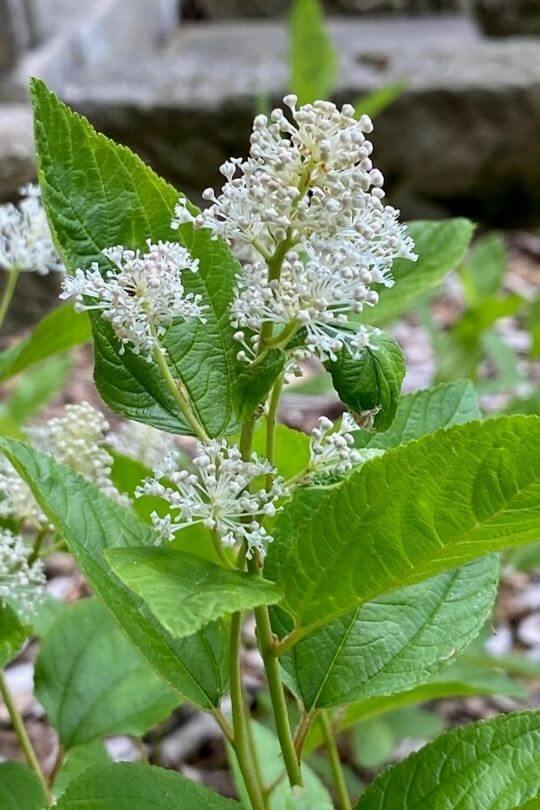
Every spring, this low growing shrub with an upright habit will fill with clumpy inflorescences with an irresistible scent for pollinators but also attractive to hummingbirds.
The flowers the,selves are actually very small, but there are so many packed together that your flying visitors will never miss them.
It is an excellent cover for slopes and banks, bit also good in borders and informal gardens general.
13. Hummingbird Trumpet (Epilobium canum)
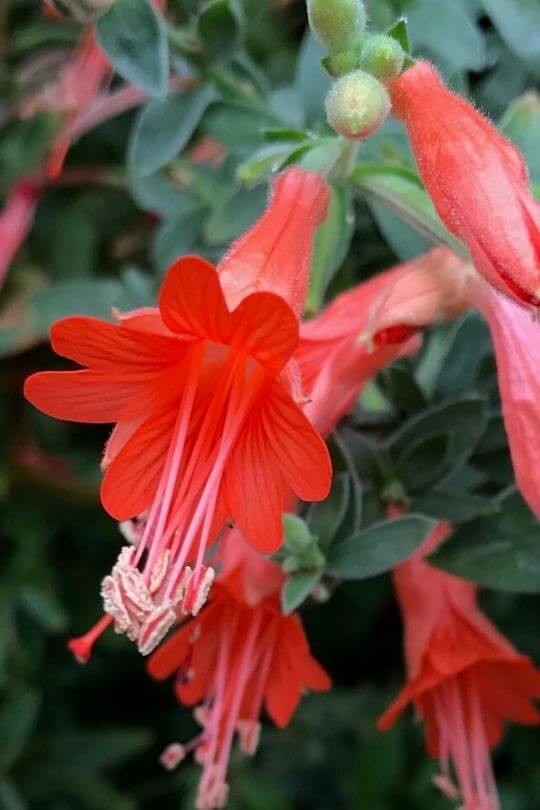
Most of us have seen pictures of humming birds inserting their long bills into the long, tubular and red flowers of the aptly called hummingbird trumpet…
How could we miss this plant from our list then?
You know which shrub I am talking about… It has upright stems clustered with long, trumpet like flowers that open like small red stars and you can see the stamen and pistils sticking out… And a hummingbird too in most pictures…
The ‘Dublin’ cultivar has won the Award of Garden Merit by the RHS and it has a particularly deep crimson red color.
This is a great plant to attract hummingbirds to your beds and borders, bit also to rock and gravel gardens.
14. Red Buckeye (Aesculus pavia)
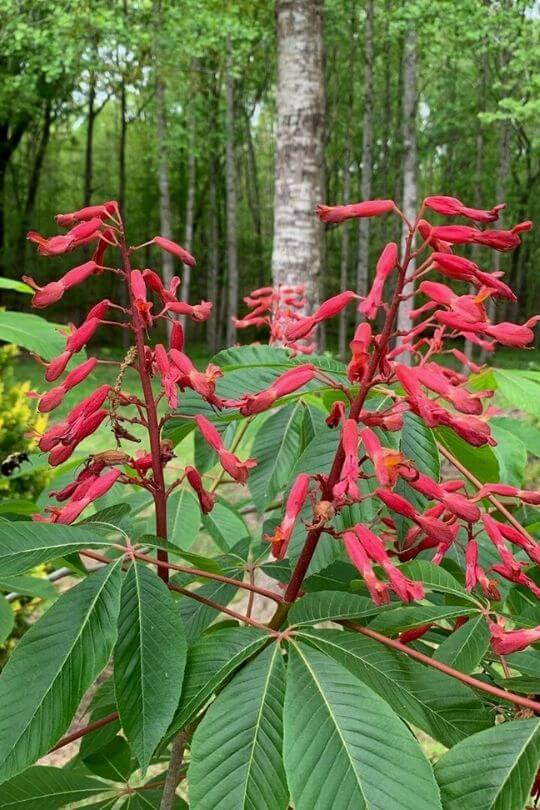
To give an attractive source of nectar to your hummingbirds high up above your head, red buckeye is a large shrub or small tree that will produce beautiful panicles of tubular bright red flowers scattered in the dense and green canopy of this deciduous plant.
You can use it as a standalone tree or as windscreen or part of a large hedge, but in each case, if there is a hummingbird within flying distance, it will come to visit you.
15. Beardtongues (Penstemon spp.)
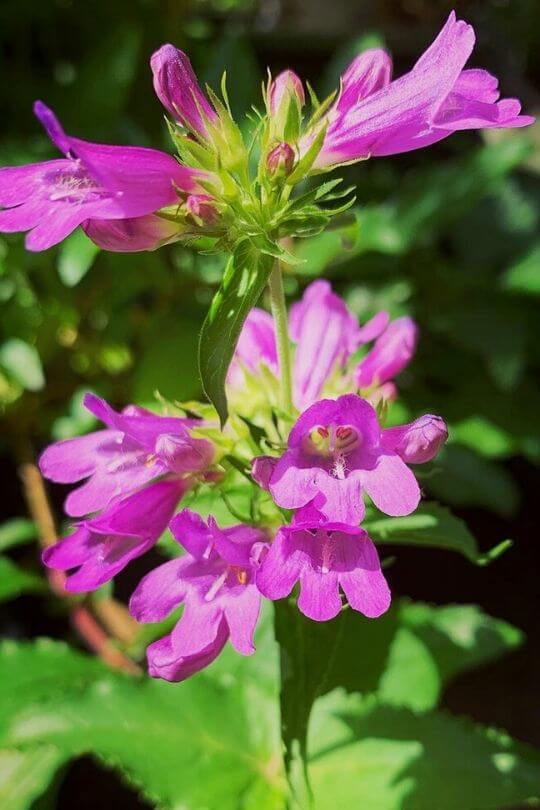
Ok, imagine being a small hummingbird and seeing a large, trumpet shaped flower in front of you, sometimes with a brighter center, at times even of a different color…
Actually imagine having a whole spike of these flowers… how could you resist beardtongue?
These busy perennials are vigorous bloomers, providing a generous and steady supply of nectar to pollinators and humming birds alike.
There are many species and varieties too. For example, prairie beardtongue (Penstemon cobaea) is a natural lilac species you will find in the wild, while ‘George Home’, impossible to resist for hummingbirds, is a cultivar with bright deep magenta flowers and a white and veined center and winner of the Award of Garden Merit by the Royal Horticultural Society.
These are wonders in cottage gardens and borders, and of course wild meadows and prairies, but as it tolerates salty habitats, it is also ideal hummingbird flower for coastal gardens.
16. Big Berry Manzanita (Arctostaphylos glauca)
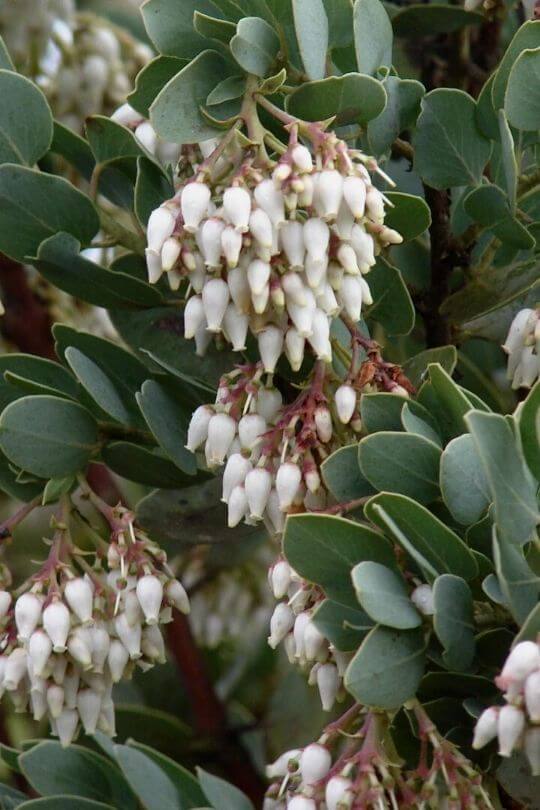
Now, let’s attract hummingbirds on a large scale… This beautiful tree (or large shrub) does not only have beautiful blue green elliptical fleshy leaves, reddish brown bark and branches, but also clusters of waxy, white and bell shaped flowers hanging like lampshades from the tips of the its smaller branches… and loads of them!
As a tree, you can use it as a standalone presence in your garden, but it can also mix in with other plants in large hedges and windscreens, and it is particular.y suited for slopes and banks in Mediterranean gardens.
17. Mountain Laurel (Kalmia latifolia)
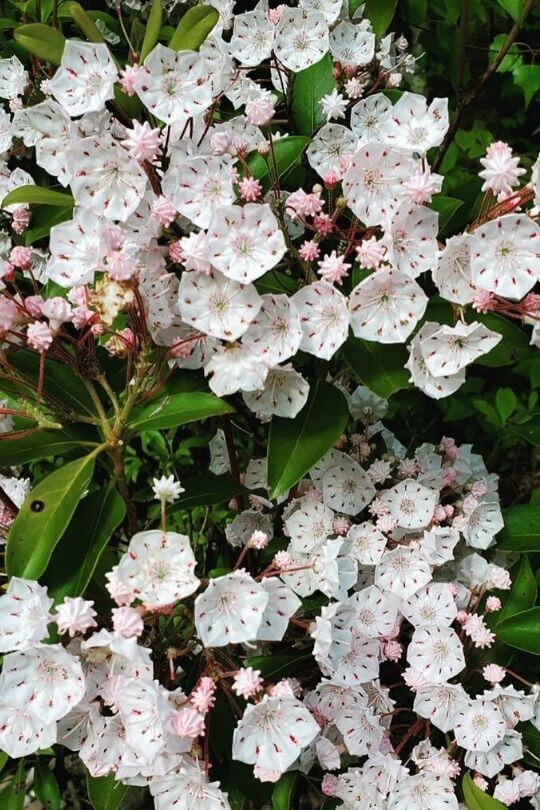
You will see a sea of pentagonal flowers, with joint petals, either white or pink from late spring to early summer with mountain laurel and, if any hummingbird is within reach, it will not fail to visit your garden.
This is an extremely decorative evergreen shrub with dark green glossy oval leaves that will keep your borders or hedges alive all year round, while exploding with color, butterflies and hummingbirds during the blooming season.
18. Bee Balm (Monarda didyma)
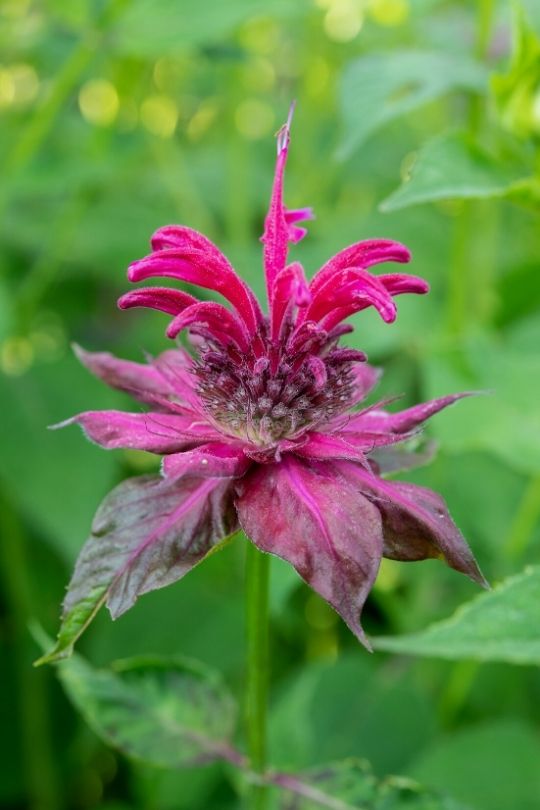
This herbaceous perennial plant will grow round flowering heads with a crown of flowers that look like the beaks of birds; and hummingbirds love them.
They are very generous bloomers and they will start in summer and end in fall, filling borders and beds with lots of flowers.
There are many cultivars and varieties, but a noteworthy one is ‘Squaw’, which has amazingly vibrant purple red flowers and has won the Award of Garden Merit by the RHS.
19. Mountain Larkspur (Delphinium glaucum)
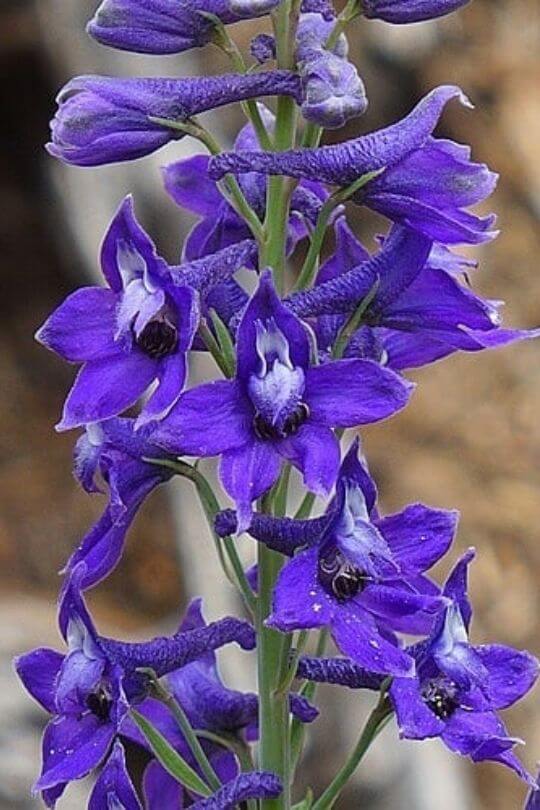
Native of the West Coast, this beautiful, tall herbaceous plant with deep violet blue flowers that look like medieval hats, or ancient drinking vessels is a good plant to attract humming birds too. And when in bloom, from July to August, they surely will not miss it!
Fast growing and ideal for wild prairies, informal borders and hedges but also cottage gardens, with an upright position and spring blossoms, mountain larkspur will attract wildlife to your garden like few other plants.
20. Clematis ‘Pamela Jackman’ (Clematis alpina ‘Pamela Jackman’)
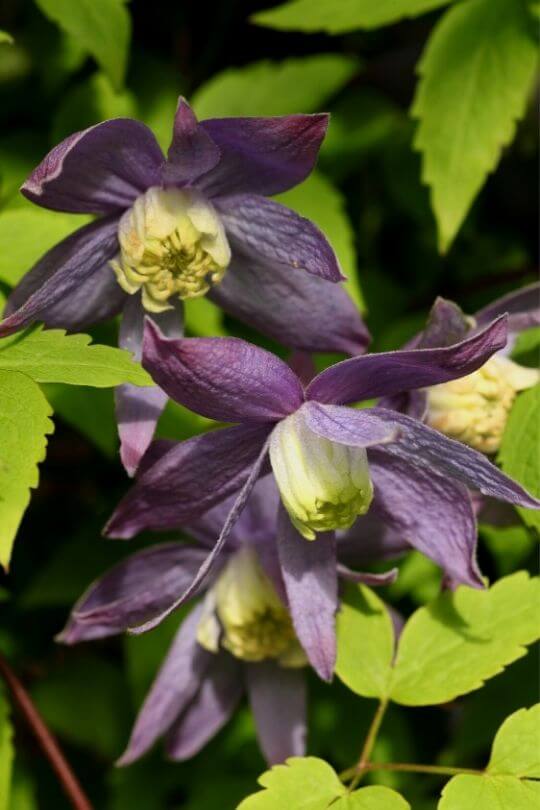
This amazing variety of clematis puts on an impressive display with its violet blue flowers, and one that hummingbirds cannot resist!
While this climber will adorn your trellises and gazebos with green foliage, the flowers will appear in mid spring and last till late summer at times…
But that’s not all; unlike other varieties, the buds will dangle and point down and they will only open slowly, first to a bell shaped flower, and then finally flat like other clematis…
Imagine this on a wall, fence or pergola, and then add the tiny but colorful hummingbirds to have the final effect of this winner of the Award of Garden Merit by the RHS!
Your Humming Garden
With butterflies, bees and hummingbirds, gardens come alive…
They add movement, that sudden flutter of surprise and amazement as you walk by… but also a sense of having a living garden, one that also animals can call home.
Attracting hummingbirds to your garden is more than a craze, it is an act of love, a love for Nature, for your garden, for your children and, of course, for your little flying guests too, and, as you can see.
There are many plants and flowers you can choose from, some small, some big, some more suitable for wild borders, others even for containers, but they all have one thing in common: they are all just gorgeous, and even more so when they have a little and colorful bird humming by its flowers.

Written By
Amber Noyes
Amber Noyes was born and raised in a suburban California town, San Mateo. She holds a master’s degree in horticulture from the University of California as well as a BS in Biology from the University of San Francisco. With experience working on an organic farm, water conservation research, farmers’ markets, and plant nursery, she understands what makes plants thrive and how we can better understand the connection between microclimate and plant health. When she’s not on the land, Amber loves informing people of new ideas/things related to gardening, especially organic gardening, houseplants, and growing plants in a small space.
